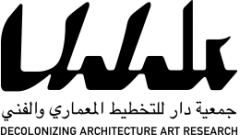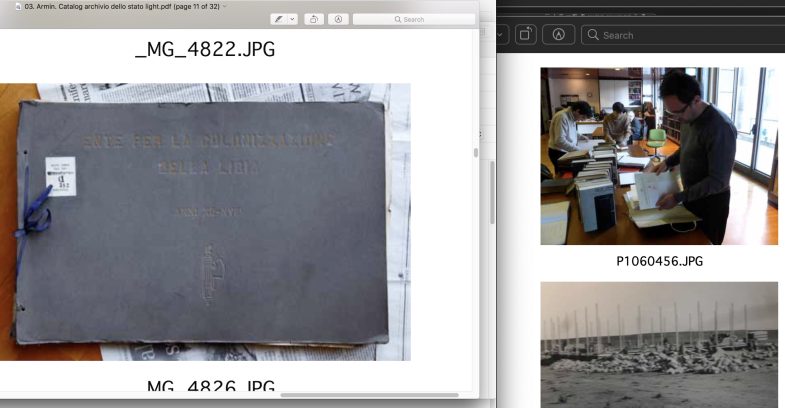The Afterlives of Fascist-Colonial Architecture
Notes for a research program (2014-2018-2022)
Alessandro Petti
The afterlives of fascist-colonial architecture is a multimedia and collective research program that studies and proposes the reuse of colonial, fascist and modernist architectures for aims different from what they were designed for. It takes the form of exhibitions, pedagogical programs, and texts.
The research program emerged from the necessity to challenge fascist, colonial and modernist mythologies still present today in public discourses, spaces, and institutions. With the re-emergence of fascist ideologies in Europe, it becomes urgent to ask: what kind of heritage is this fascist-colonial heritage? How do the material traces of colonial and fascist architecture today acquire different meanings in the context of migration from the ex-colonies? How has the right to re-use it? Should this heritage be demolished or re-oriented towards other aims, including reparations from colonization?
Once primarily located outside of Europe, the struggle of decolonization has today another front within its borders and peripheries. What the media continue to call the “refugee crisis” is, in reality, the incapacity of Europe to come to terms with five hundred years of colonialism. It is not possible to understand today’s displacement of people, its flows of migration, or contemporary fascism, without a thorough knowledge of Europe’s colonial heritage.
This research aims to challenge the classically material and aesthetic framework for understanding colonial architecture, proposing to treat architectural space as the product of social, political, and economical transformation, and thus a privileged site its analysis; and expand upon and re-conceptualize colonial experience by investigating the continuities and discontinuities between past and contemporary forms of colonial space.
The project emerged after several years of work in Palestine (2002-2016) where Decolonization means essentially the practice of opposing Israel’s regime of occupation, colonization, and segregation. Moving back to Europe, via Palestine, I started to understand the “Italian southern question” more clearly as a case of internal colonization. Needless to say, this connection is not new—in writing the Question of Palestine, Edward Said was influenced by the Gramscian conceptual categories of subalternity and hegemony developed in relation to “the Italian southern question.”
The first chapter materialized in 2014 on the occasion of the Venice Architectural Biennal, by focusing on agricultural colonies built by the fascist regime in the early 1930s on the coast of Libya, and the complementary displacement and deportation of two-thirds of the Libyan population to refugee camps to the east. The modernist architecture of Italian fascist-colonialism could only exist on a tabula rasa created by such treatments of a local population, who were perceived either as a threat and anti-modern or in need of civilization. This chapter resulted in an installation that turned a confessional inside out, shifting it from being a religious-psychological apparatus for personal redemption into a political tool that calls for the exposure of the neo-colonial relations that still tie Europe and Africa in thousands of webs. (Italian Ghosts, 2014)
The second chapter moved the gaze from former colonies to Italian towns in southern Italy. The population of southern Italy has been depicted as backward, underdeveloped, and lazy; a similar trope to what is applied to colonized populations. Within the framework of the academic course Decolonizing Architecture at the Royal Institute of Art in Stockholm, and on the occasion of Manifesto 12 in Palermo, this chapter took the form of an architectural prosthesis and discursive exhibition at the Casa del Mutilato in Palermo, a fascist building inaugurated by Benito Mussolini in 1936. (Casa Del Mutilato, Palermo 2018)
The third chapter was centered around Asmara and Addis Abada, as case studies for the re-appropriation of colonial fascist heritage. The analysis of the ways in which colonial architecture has been re-utilized represents a privileged and new arena to understand broader political and cultural issues around national identity, a sense of belonging, alienation, social control, and urban subversion. (Asmara and Addis Ababa, 2019)
The fourth chapter entitled “Towards an Entity of Decolonization” was presented on the occasion of Quadriennale d’Arte 2020 – FUORI at Palazzo delle Esposizioni in Rome, home to the first international exhibition of colonial art (1931) and other propaganda exhibitions of the regime, proposes to rethink the villages built by fascism in Sicily starting from the appointment of Asmara as a world heritage site. The installation was the first step towards the creation of an Entity of Decolonization that will be open to those who feel the urgency to question a broad historical, cultural and political heritage steeped in colonialism and fascism, and thus start a common path towards new practices of decolonization and de-fascistization. (Towards an Entity of Decolonization)
The fifth chapter took the form of an educational program, the Difficult Heritage Summer School a collaboration between the Decolonizing Architecture Course at the Royal Institute of Art in Stockholm and the Critical Urbanism course at the University of Basel run by Emilio Distretti. The Difficult Heritage Summer School is constituted by a series of lectures, seminars, workshops, readings, and site visits centered around the rural town of Borgo Rizza, build in 1940 by the Entity of Colonization of Sicilian Latifundium established by the fascist regime to colonize the souther contryside of Italy perceived as backward and underdeveloped. The summer school has helped the local municipality of Cerlentini to transform the abandoned town into a new civic space for local organizations and international universities. The town offers the opportunity to analyze, reflect and intervene in the debate regarding the architectural heritage associated to painful and violent memories and more broadly to problematize the colonial relationship with the countryside. (Difficult Heritage I, Borgo Rizza 2021)
Ente di Decolonizzazione – Borgo Rizza – is a most recent chapter supported by the Italian Council (2021), which explores the possibility of critical reused and subversion of colonial fascist architecture through an art installation. Starting from the composition and recomposition of the facade of the entity of colonization built in Borgo Rizza (Siracusa), the installation is made of a series of modules-sittings that are the platform of an open discursive space where the public is invited to reconsider critically the social, political and economic effects of fascist and colonial heritage and at the same time is invited to image collectively new common uses. The installation is presented and activated in several venues in Napoli (2022), Berlin (2022), Bruxells (2023) and Albissola Marina (2023). Ente di Decolonizzazione – Borgo Rizza –

